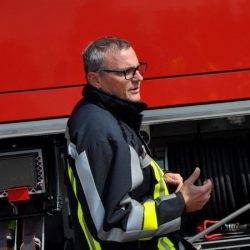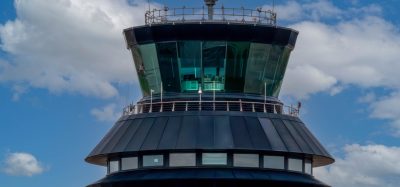The life of an airport firefighter – an exclusive insight into Munich Airport
Posted: 22 November 2019 | Leah Hockley (International Airport Review) | No comments yet
International Airport Review’s Junior Editor, Leah Hockley, spoke with Munich Airport’s Main Fire Chief, Lars Boehlkau to explore the daily routines of an airport firefighter.


Copyright: Munich Airport
The sight to be seen at the training facility of Munich Airport’s fire department is like one out of a disaster movie: The burned-out wreckage of a car, discarded by a pile of rusted shipping containers; and an immense replica of a Jumbo jet fuselage, rust-brown from being the subject of a multitude of emergency practices.


Copyright: Munich Airport
Not far from the south runway of the airport, the fenced-in site of the training facility is home to airport fire crews conducting regular drills and simulations, helping firefighters to practice firefighting in buildings and rescues from great heights. In order to prepare for response in realistic conditions, a wide range of sophisticated technology is utilised in order to make the drills as accurate as possible.
Quick response is an absolute priority, and the fire team – consisting of up to 160 firefighters and 32 vehicles – are available for deployment in case of emergency and are prepared to respond around the clock. The practice sessions that take place at the training facility enable the fire crews to maintain their operational readiness, honing their skills in order to be able to undertake a well-rehearsed and played-to-perfection response when acting in a real emergency.
Standard training involves triggering multiple fires at various locations throughout aircraft, with pre-installed piping delivering natural gas that is remotely ignited. Trainees receive the starting signal and, from that moment on, every second counts – time is crucial and cannot be wasted, in order to ensure that all passengers are rescued from the fully-loaded aircraft. The firefighters must first attempt to stop the engine fire from spreading to the cabin, otherwise running the risk of the fuel tanks exploding. Emergency response vehicles rush to the scene, taking position at a safe distance from the aircraft. Hoses are unwound and prepared as fast as possible, and the firefighters begin their assault on the fire.


Copyright: Munich Airport
In yet another simulation, the aircraft is seen to be fully engulfed in flames and the left wing has already lost the battle. This kind of emergency can result in multiple injuries and holds a hefty risk of high mortality rates. Emergency vehicles rush to the scene – while the driver focuses on getting as quickly as possible to the emergency site, a colleague begins positioning the water jet nozzles to aim directly at the fire source before the vehicle comes to a halt.
The airport is home to one of the most advanced fire engines in the world – the 1,000 horsepower Ziegler Z8 Snozzle. Equipped with seven protective nozzles that are able to shoot water in order to fend off flames, and a roof-mounted water turret – able to project 4,500 litres of water per minute – the vehicle uses a 480 horsepower pump engine to propel the 12,500 litres of water carried in its tanks.
A brand-new tunnel, located in the South Fire Station training centre, allows for firefighters to train in their emergency outfit and breathing masks. Firefighters work their way in teams through cage-like corridors, past obstacles and up narrow ladders. The exercise is designed to test the fitness and lung function of the firefighters under as realistic conditions as possible.
What does it take to be an airport firefighter?


Munich Airport’s Main Fire Chief, Lars Boehlkau
International Airport Review’s Junior Editor, Leah Hockley, spoke with Munich Airport’s Main Fire Chief, Lars Boehlkau, about his role at the airport and what life is like for an airport firefighter.
How long have you been working for Munich Airport’s Fire Department? Can you give us an insight into your day-to-day role?
I have been with the airport fire department since 2002. The fire department operates 24 hours a day; our shift starts at 07:15 and we work for 8.2 hours – during this time, every firefighter works in his special subject field, only interrupted by possible alarms. My subject fields are public relations, internal and external education, and training. We are required to complete one hour of official sport training every shift. After the 8.2 working hours, we have 16 hours on-call emergency service, directly at the fire department office. The shift ends the next day at 07:15, and we then have 24 hours off.
How varied are the emergencies that you respond to at the airport?
Operations could not vary more – from a small oil slick or animal rescue, to life-saving operations or serious traffic accidents.
How do you prepare for the unknown?
No operation or action is alike – experience comes with the working years and, of course, the constant practice and training of different situations helps a lot.
What equipment do you use for training?
For the training we use our regular equipment, that is made ready for use again after the exercise.
What do you find most rewarding about the job?
It is a very varied job and what enriches me the most is the gratitude of the people who we have helped.
On the subject of the training exercises undertaken by firefighters, Boehlkau said: “Our training facility provides us with the perfect set-up to practice rescue missions under highly realistic conditions. That ensures that we are ready at all times – although we very much hope that we will never experience a real emergency. But we’re prepared – 24 hours a day, 365 days per year.”
Related topics
Accidents and incidents, Aircraft rescue and firefighting (ARFF), Airport crisis management, Safety

















